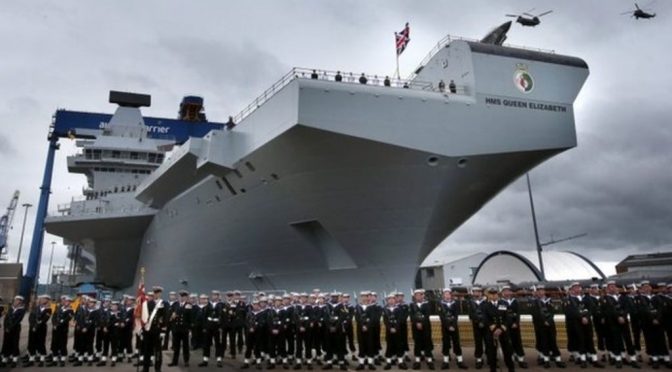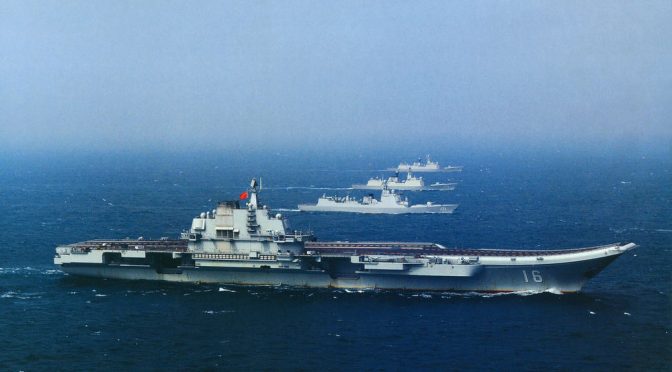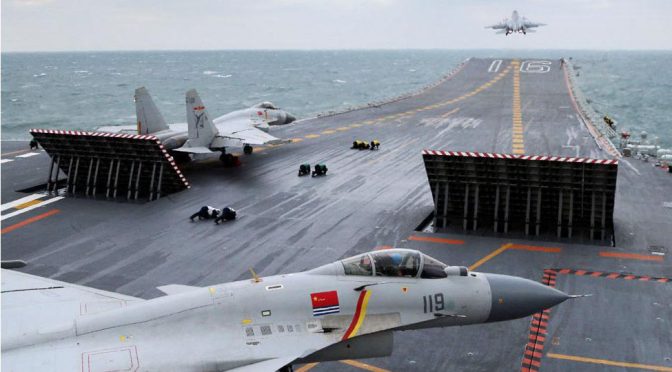The Red Queen’s Navy
Written by Vidya Sagar Reddy, The Red Queen’s Navy will discuss the  influence of emerging naval platforms and technologies in the geostrategic contours of the Indo-Pacific region. It identifies relevant historical precedents, forming the basis for various maritime development and security related projects in the region.
influence of emerging naval platforms and technologies in the geostrategic contours of the Indo-Pacific region. It identifies relevant historical precedents, forming the basis for various maritime development and security related projects in the region.
“Now, here, you see, it takes all the running you can do, to keep in the same place.”– The Red Queen, Through the Looking Glass, Lewis Carroll.
By Vidya Sagar Reddy
Introduction
China’s sole aircraft carrier, the Liaoning, had put on a display of its skills recently as the carrier group transited the Western Pacific. Liaoning’s excursion, marking Beijing’s core interests, is a political message to the United States and the world as uncertainty grips them. It also marks the beginning of a new episode in the military history of Western Pacific, which has been dominated by American aircraft carriers since the Cold War, especially during the Taiwan Strait crises. Taiwan also believes that Liaoning represents China’s military ability to break through the first island chain.
Historical Context
A recount of Cold War history and Beijing’s narratives of its historical and maritime supremacy in the Western Pacific serves to put this development into a more sober perspective, informing future political and military balance in the region.
China’s civil war led to Communists controlling the mainland territory while the Nationalists retreated to Taiwan. Subsequently, the People’s Republic of China and Republic of China were established on either side of the Taiwan Strait. In the 1950s, the U.S. drew up security and mutual defense treaties with Japan, South Korea, the Philippines, Australia, and New Zealand as a bulwark of its containment policy against the spread of Communism in Asia. The U.S. also extended its diplomatic and military support to Taiwan while confronting China in the Korean and Vietnam Wars.
In the 1950s, China and Taiwan clashed over the control of strategically located islands in the Taiwan Strait. The U.S. deployed its naval assets to the Strait, forcing cessation of hostilities and also signaling its political will to defend Taiwan from military aggression. However, U.S.-China relations improved in the 1970s with the former recognizing the PRC. The diplomatic recognition by the U.S. helped China modernize its industries and expand its economy.
As China’s domestic circumstances and international stature improved, it sought to define its national interests. In 2003, China’s Foreign Minister, Tang Jiaxuan, identified Taiwan as one of China’s “core interests” in his meeting with then U.S. Secretary of State, Colin Powell. The subsequent official writings use terms such as ‘upholding territorial integrity and national sovereignty’ and ‘reunification’ in an attempt to extend China’s sovereignty over Taiwan. The South China Sea was included in the ‘core interests’ in 2010 and the disputed Senkaku/Diaoyu islands in the East China Sea in 2013. China is undertaking reforms and modernizing its military capabilities to attain and defend these core interests.
Admiral Liu Huaqing, called China’s Mahan, was the most influential in lobbying for a blue-water navy for the country. He oversaw the radical modernization of China’s navy in terms of concepts, strategies, and capabilities. He even drew up a timeline for China’s navy to be able to exert sea control within the first island chain by 2000, control second island chain waters by 2020 and project power as a true global navy by 2050. The aircraft carrier is the quintessential military platform that embodies such intentions, particularly for global power projection. The fact that American aircraft carriers operating across the globe, including the Western Pacific, underline this fact to China.
Signaling Capability and Strategic Intent
Liaoning then speaks of Beijing’s political will and ambition to break through the first island chain, which China considers a geographical and political containment of its power. The first island chain is a virtual line drawn from the islands of Japan passing Taiwan and the Philippines and curving at the southern end of the South China Sea between Malaysia and Vietnam. Variations include the line either passing through the west coast or the east coast of Taiwan as well as extension of the line through the Indonesian archipelago to even reach Diego Garcia in the Indian Ocean. In any case, China is bound to come in contact with its immediate neighbors Japan, South Korea, Vietnam, Malaysia, and the Philippines, countries with which it shares a long, complex history of both cooperation and conflict.
China has also shown its knack for picking its moments to send political messages using military means. It took advantage of the world’s fixated attention on the U.S. intervention in Lebanon in 1958 to resume the bombing of Jinmen and Mazu islands in the Taiwan Strait. China’s armed incursion across the Indian border in 1962 coincides with the Cuban Missile Crisis. At present, the domestic political transition phase of the U.S. had lent Liaoning political space to carry out its objectives in support of Beijing’s core interests. Liaoning’s excursion also occurred just as President Trump signaled possible recalibration of ‘One China’ policy before his inauguration. Carrier operations require significant advance preparation, so while President Trump’s comments may not have triggered the Liaoning’s transit, the Chinese surely planned this December deployment well in advance of the U.S. election to send a message to the U.S. president-elect, whomever it would be.
China has liberally shared photographs and videos of Liaoning’s deck operations, perhaps as an aid to counter the criticism of its minimal experience in carrying out carrier operations in deep seas. Nevertheless, China cannot be expected to master those skills and capabilities inherent to maintaining a carrier strike group as its Asian peer India or the U.S. have acquired over many decades and at considerable costs. Most importantly, before China can earn international prestige, Liaoning or its successors must operate outside the overshadowing Anti-Access/Area Denial protective bubble and sustain their operations to become true power projection assets.
https://gfycat.com/UnkemptShortDeinonychus
Liaoning operations in December 2016. PLA Navy chief Admiral Wu Shengli is seen shaking hands and speaking to crew members. (CCTV)
Even if it is the intention of China to intimidate its smaller neighbors by parading the Liaoning in the near seas, investing the financial and human resources demanded by an aircraft carrier in the Coast Guard and maritime militia makes better sense. China’s maritime militia deployed on the open seas backed by the Coast Guard and the Navy has emerged as the true instrument of coercion for altering the status quo in the South China Sea, complicating the response mechanisms of disputant countries while the U.S. has yet to officially recognize it as a concentrated force.
Extending the cost-benefit perspective to a wartime situation, it again makes better sense for China to continue investing in its missile capabilities that better serve its sea denial strategy against an adversary advancing over the seas towards its shores. The new classes of China’s destroyers and submarines, owing to their numbers and increasing technological sophistication, are already considered formidable. Even if the carriers are able to extend the reach of China’s military aircraft over the seas, they would tie down some of the aircraft and naval assets for protection against the adversary’s own long-range missile strikes.
Conclusion
In essence, China has made a fine point: it finally possesses a steaming aircraft carrier that has operated without incidents on its first venture over the seas. Beijing successfully highlighted and marked some of its core interests. While Liaoning’s foray into the seas certainly sets a mark in the fluctuating military balance of the Asia-Pacific, China has some decent obstacles to maneuver before it can claim or demand recognition for possessing an aircraft carrier. And given China’s zero tolerance for accidents, it remains to be seen how the cautious approach would help China gain mastery in this domain. As the carrier operations continue and more platforms join the Navy, China will have to determine if these platforms are indeed worth the risk and costs. Even so, China needs to assess the optimum roles that can be assigned to its carriers within the country’s overarching political and military strategies.
Vidya Sagar Reddy is a research assistant in the Nuclear and Space Policy Initiative of the Observer Research Foundation, New Delhi.
Featured Image: Liaoning steams with PLA Navy surface combatants. (Andreas Rupprecht, via China Defense Forum)



 influence of emerging naval platforms and technologies in the geostrategic contours of the Indo-Pacific region. It identifies relevant historical precedents, forming the basis for various maritime development and security related projects in the region.
influence of emerging naval platforms and technologies in the geostrategic contours of the Indo-Pacific region. It identifies relevant historical precedents, forming the basis for various maritime development and security related projects in the region.
